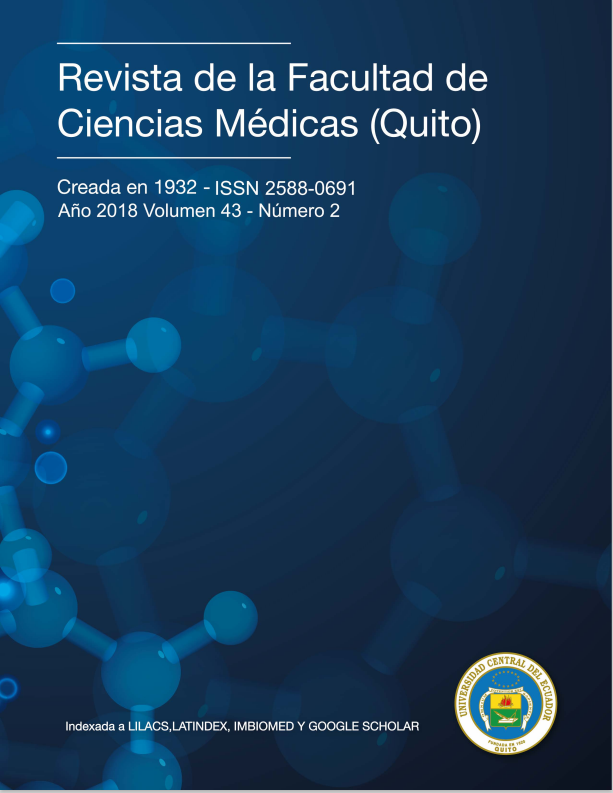The delay in the start time of classes significantly increases adolescent performance, a reflection for Public Health in Ecuador: a narrative review
DOI:
https://doi.org/10.29166/rfcmq.v43i2.2821Keywords:
Ecuador, sleep deprivation, adolescent health, Public Health, academic performanceAbstract
Context: In Ecuador, there are no published studies on the hours of sleep by age groups, or start times of classes focused on the academic performance of the population, especially adolescents. Discussion: When collecting data from studies conducted in children and adolescents, adolescents need enough sleep to function well daily, and improve the cognitive effects that occur due to lack of sleep. Considering that only 14% to 27% of adolescents sleep more than 9 hours on school nights, and worse, up to 25% sleep less than 6 hours, it is not surprising that most adolescents wake up feeling tired. It recommends to plan the sleep hours with parents, homework schedule, and physical activity schedules, to train the mind and have good sleep hygiene Conclusion: The delay of the start time of classes significantly increases the performance in adolescents, so public policies have be changed to allow the time of entry to classes to be past 9 am.
Downloads
Metrics
References
Chaput JP, Dutil C, Sampasa-Kanyinga H. Sleeping hours: what is the ideal number and how does
age impact this?. Nat Sci Sleep. 2018;10:421–430. Published 2018 Nov 27. doi:10.2147/NSS.S163071
de Lima TR, Silva DAS. Association of sleep quality with sociodemographic factors and lifestyle
in adolescents from southern Brazil. World J Pediatr. 2018;14(4):383–391. doi:10.1007/s12519-018-
-8
Minges KE, Redeker NS. Delayed school start times and adolescent sleep: A systematic review of the
experimental evidence. Sleep Med Rev. 2016;28:86–95. doi:10.1016/j.smrv.2015.06.002.
Alsaggaf MA, Wali SO, Merdad RA, Merdad LA. Sleep quantity, quality, and insomnia symptoms of
medical students during clinical years. Relationship with stress and academic performance. Saudi
Med J. 2016;37(2):173–182. doi:10.15537/smj.2016.2.14288
Wheaton AG, Chapman DP, Croft JB. School Start Times, Sleep, Behavioral, Health, and Academic
Outcomes: A Review of the Literature. J Sch Health. 2016;86(5):363–381. doi:10.1111/josh.12388
Chaput JP, Dutil C, Sampasa-Kanyinga H. Sleeping hours: what is the ideal number and how does
age impact this?. Nat Sci Sleep. 2018;10:421–430. Published 2018 Nov 27. doi:10.2147/NSS.S163071
Instituto Nacional de Estadísticas y Censos. Compendio de Resultados - Encuesta Condiciones de
Vida ECV- Sexta Ronda, 2015. Disponible en: http://www.ecuadorencifras.gob.ec/documentos/webinec/ECV/ECV_2015/documentos/ECV%20COMPENDIO%20LIBRO.pdf
Krueger JM, Nguyen JT, Dykstra-Aiello CJ, Taishi P. Local sleep. Sleep Med Rev. 2019;43:14–21.
doi:10.1016/j.smrv.2018.10.001
Hirshkowitz M, Whiton K, Albert SM, et al. National Sleep Foundation’s sleep time duration recommendations: methodology and results summary. Sleep Health. 2015;1(1):40–43. doi:10.1016/j.
sleh.2014.12.010
Tremblay MS, Carson V, Chaput JP, et al. Canadian 24-Hour Movement Guidelines for Children and
Youth: An Integration of Physical Activity, Sedentary Behaviour, and Sleep. Appl Physiol Nutr Metab.
;41(6 Suppl 3):S311–S327. doi:10.1139/apnm-2016-0151
Boyko Y, Jennum P, Toft P. Sleep quality and circadian rhythm disruption in the intensive care unit: a
review. Nat Sci Sleep. 2017;9:277–284. Published 2017 Nov 10. doi:10.2147/NSS.S151525
Owens J; Adolescent Sleep Working Group; Committee on Adolescence. Insufficient sleep in adolescents and young adults: an update on causes and consequences. Pediatrics. 2014;134(3):e921–e932.
doi:10.1542/peds.2014-1696
Wheaton AG, Chapman DP, Croft JB. School Start Times, Sleep, Behavioral, Health, and Academic
Outcomes: A Review of the Literature. J Sch Health. 2016;86(5):363–381. doi:10.1111/josh.12388.
Minges KE, Redeker NS. Delayed school start times and adolescent sleep: A systematic review of the
experimental evidence. Sleep Med Rev. 2016;28:86–95. doi:10.1016/j.smrv.2015.06.002.
Adolescent Sleep Working Group; Committee on Adolescence; Council on School Health. School
start times for adolescents. Pediatrics. 2014;134(3):642–649. doi:10.1542/peds.2014-1697.
Guerrero MD, Barnes JD, Chaput JP, Tremblay MS. Screen time and problem behaviors in children:
exploring the mediating role of sleep duration. Int J Behav Nutr Phys Act. 2019;16(1):105. Published
Nov 14. doi:10.1186/s12966-019-0862-x
Bartel KA, Gradisar M, Williamson P. Protective and risk factors for adolescent sleep: a meta-analytic
review. Sleep Med Rev. 2015;21:72–85. doi:10.1016/j.smrv.2014.08.002
Al-Hazzaa HM, Alhussain MH, Alhowikan AM, Obeid OA. Insufficient Sleep Duration And Its As sociation With Breakfast Intake, Overweight/Obesity, Socio-Demographics And Selected Lifestyle
Behaviors Among Saudi School Children. Nat Sci Sleep. 2019;11:253–263. Published 2019 Oct 25.
doi:10.2147/NSS.S225883
Irwin MR. Why sleep is important for health: a psychoneuroimmunology perspective. Annu Rev
Psychol. 2015;66:143–172. doi:10.1146/annurev-psych-010213-115205
Royal Philips (NYSE: PHG, AEX: PHIA) empresa líder en tecnología de la salud, enfocada en mejorar la salud de las personas. Disponible en: https://www.philips.com.ar/aw/about/news/archive/standard/news/press/2018/20180611-encuesta-latinoamericana-sobre-el-sueno.html
Abrams RM. Sleep Deprivation. Obstet Gynecol Clin North Am. 2015;42(3):493–506. doi:10.1016/j.
ogc.2015.05.013.
McEwen BS, Karatsoreos IN. Sleep Deprivation and Circadian Disruption: Stress, Allostasis, and
Allostatic Load. Sleep Med Clin. 2015;10(1):1–10. doi:10.1016/j.jsmc.2014.11.007
McHill, A. W., Hull, J. T., Wang, W., Czeisler, C. A., & Klerman, E. B. (2018). Chronic sleep curtailment, even without extended (>16-h) wakefulness, degrades human vigilance performance. Proceedings of the National Academy of Sciences, 115(23), 6070–6075. doi:10.1073/pnas.1706694115 .
Tobaldini E, Costantino G, Solbiati M, et al. Sleep, sleep deprivation, autonomic nervous system
and cardiovascular diseases. Neurosci Biobehav Rev. 2017;74(Pt B):321–329. doi:10.1016/j.neubiorev.2016.07.004
Maric A, Montvai E, Werth E, et al. Insufficient sleep: Enhanced risk-seeking relates to low local sleep
intensity. Ann Neurol. 2017;82(3):409–418. doi:10.1002/ana.25023
Taveras EM, Rifas-Shiman SL, Bub KL, Gillman MW, Oken E. Prospective Study of Insufficient Sleep
and Neurobehavioral Functioning Among School-Age Children. Acad Pediatr. 2017;17(6):625–632.
doi:10.1016/j.acap.2017.02.001
Tremblay MS, Chaput JP, Adamo KB, et al. Canadian 24-Hour Movement Guidelines for the Early
Years (0-4 years): An Integration of Physical Activity, Sedentary Behaviour, and Sleep. BMC Public
Health. 2017;17(Suppl 5):874. Published 2017 Nov 20. doi:10.1186/s12889-017-4859-6
Taveras EM, Rifas-Shiman SL, Bub KL, Gillman MW, Oken E. Prospective Study of Insufficient Sleep
and Neurobehavioral Functioning Among School-Age Children. Acad Pediatr. 2017;17(6):625–632.
doi:10.1016/j.acap.2017.02.001
Moreira GA, Pradella-Hallinan M. Sleepiness in Children: An Update. Sleep Med Clin. 2017;12(3):407–
doi:10.1016/j.jsmc.2017.03.013
Touitou Y, Touitou D, Reinberg A. Disruption of adolescents’ circadian clock: The vicious circle of
media use, exposure to light at night, sleep loss and risk behaviors. J Physiol Paris. 2016;110(4 Pt
B):467–479. doi:10.1016/j.jphysparis.2017.05.001.
Badin E, Haddad C, Shatkin JP. Insomnia: the Sleeping Giant of Pediatric Public Health. Curr Psychiatry Rep. 2016;18(5):47. doi:10.1007/s11920-016-0687-0
Bathory E, Tomopoulos S. Sleep Regulation, Physiology and Development, Sleep Duration and Patterns, and Sleep Hygiene in Infants, Toddlers, and Preschool-Age Children. Curr Probl Pediatr Adolesc Health Care. 2017;47(2):29–42. doi:10.1016/j.cppeds.2016.12.001
Knufinke M, Nieuwenhuys A, Geurts SAE, Coenen AML, Kompier MAJ. Self-reported sleep quantity, quality and sleep hygiene in elite athletes. J Sleep Res. 2018;27(1):78–85. doi:10.1111/jsr.12509
Killgore WD. Effects of sleep deprivation on cognition. Prog Brain Res. 2010;185:105–129. doi:10.1016/
B978-0-444-53702-7.00007-5
Morgenthaler TI, Hashmi S, Croft JB, Dort L, Heald JL, Mullington J. High School Start Times and
the Impact on High School Students: What We Know, and What We Hope to Learn. J Clin Sleep Med.
;12(12):1681–1689. Published 2016 Dec 15. doi:10.5664/jcsm.6358.
Touitou Y, Reinberg A, Touitou D. Association between light at night, melatonin secretion, sleep deprivation, and the internal clock: Health impacts and mechanisms of circadian disruption. Life Sci.
;173:94–106. doi:10.1016/j.lfs.2017.02.008
Badin E, Haddad C, Shatkin JP. Insomnia: the Sleeping Giant of Pediatric Public Health. Curr Psychiatry Rep. 2016;18(5):47. doi:10.1007/s11920-016-0687-0
Bartel KA, Gradisar M, Williamson P. Protective and risk factors for adolescent sleep: a meta-analytic
review. Sleep Med Rev. 2015;21:72–85. doi:10.1016/j.smrv.2014.08.002
Irwin MR. Why sleep is important for health: a psychoneuroimmunology perspective. Annu RevPsychol. 2015;66:143–172. doi:10.1146/annurev-psych-010213-115205
Fatima Y, Doi SA, Mamun AA. Sleep quality and obesity in young subjects: a meta-analysis. Obes
Rev. 2016;17(11):1154–1166. doi:10.1111/obr.12444
Dutil C, Chaput JP. Inadequate sleep as a contributor to type 2 diabetes in children and adolescents.
Nutr Diabetes. 2017;7(5):e266. Published 2017 May 8. doi:10.1038/nutd.2017.19
Kim J, Hakim F, Kheirandish-Gozal L, Gozal D. Inflammatory pathways in children with insufficient
or disordered sleep. Respir Physiol Neurobiol. 2011;178(3):465–474. doi:10.1016/j.resp.2011.04.024
Shekari Soleimanloo S, White MJ, Garcia-Hansen V, Smith SS. The effects of sleep loss on young
drivers’ performance: A systematic review. PLoS One. 2017;12(8):e0184002. Published 2017 Aug 31.
doi:10.1371/journal.pone.0184002
Urry E, Landolt HP. Adenosine, caffeine, and performance: from cognitive neuroscience of sleep to
sleep pharmacogenetics. Curr Top Behav Neurosci. 2015;25:331–366. doi:10.1007/7854_2014_274
Jamieson D, Broadhouse KM, Lagopoulos J, Hermens DF. Investigating the links between adolescent
sleep deprivation, fronto-limbic connectivity and the Onset of Mental Disorders: a review of the
literature [published online ahead of print, 2019 Aug 29]. Sleep Med. 2019;66:61–67. doi:10.1016/j.
sleep.2019.08.013
Almojali AI, Almalki SA, Alothman AS, Masuadi EM, Alaqeel MK. The prevalence and association
of stress with sleep quality among medical students. J Epidemiol Glob Health. 2017;7(3):169–174.
doi:10.1016/j.jegh.2017.04.005
Kopasz M, Loessl B, Hornyak M, et al. Sleep and memory in healthy children and adolescents - a
critical review. Sleep Med Rev. 2010;14(3):167–177. doi:10.1016/j.smrv.2009.10.006
Noland H, Price JH, Dake J, Telljohann SK. Adolescents’ sleep behaviors and perceptions of sleep. J
Sch Health. 2009;79(5):224–230. doi:10.1111/j.1746-1561.2009.00402.x
Bartel KA, Gradisar M, Williamson P. Protective and risk factors for adolescent sleep: a meta-analytic
review. Sleep Med Rev. 2015;21:72–85. doi:10.1016/j.smrv.2014.08.002
Downloads
Published
How to Cite
Issue
Section
License
Copyright (c) 2018 Fabricio Gonzalez-Andrade, Carolina Ocaña-Terán, Gabriela Aguinaga-Romero

This work is licensed under a Creative Commons Attribution-NonCommercial-NoDerivatives 4.0 International License.










